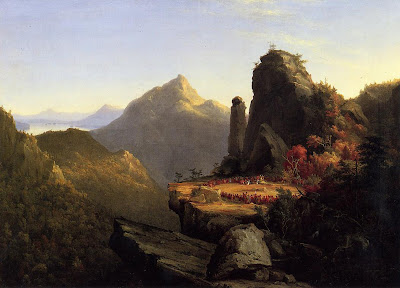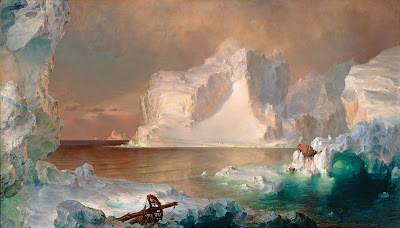What was it about? What were the goals?
The Hudson River School (not an actual school) can best be seen as America's answer to the Romantic movement in Europe. The first generation lived in and around New York City, America's first and greatest center for the arts. So, they would travel north to paint the countryside, particularly the Hudson River, the Adirondacks, the Catskills, and the White Mountains, and then exhibit their works in the city galleries. They were particularly partial to fall colors, and dramatic weather, often painting storms and lightning. Later generations went on long sailing excursions to explore the coasts of South America and beyond to the American west.
In what way was this movement Romantic? It idealized America as a pastoral land in harmony with nature, one for its people to discover, explore, and settle. It tantalized viewers with dreams of adventure, danger, riches, and mystery. In a way, it was a form of propaganda for America's dream of "manifest destiny" at a time when the nation had not yet conquered the west or taken California, but greatly wished to do so. And the best works are far too intelligent to be labeled "propaganda" of anything. But mostly, it was a celebration of the beauty and mystery of nature. In this way, it was a nostalgic movement, as NYC and the surrounding areas quickly developed and industrialized.
A bit of historical context:
The founder of this movement is Thomas Cole, who was one of the first to voyage (in 1825) on a steamer up the Hudson River for the express purpose of exploring the wilderness to paint it. Cole died young from a lung infection, perhaps from all his hiking in bad weather. His death in 1848 marks the start of the second generation of Hudson School artists, also known as the Luminists. As these artists voyaged west, a group of them became known as the Rocky Mountain School of painting, including Bierstadt, Thomas Moran, and William Keith. Several of these artists were German immigrants, having studied at the romantic Düsseldorf School of painting, an actual academy, then under the direction of artist Wilhelm von Schadow. This school was very influential in 19th century American painting as were the English painters Turner and Constable.
The name of the movement, as with most, was given by a critic as a joke, when the movement had gone out of style, with the new Barbizon School of painters coming into fashion in NYC. It's funny considering how similar the two movements were, especially at the start of the Barbizon. It would be quite a challenge to tell them apart.
The underlying philosophy of the period:
These artists generally held that in exploring and presenting nature in all its glory, they were painting the work and the gifts of God. To do so, they made huge, expansive paintings on enormous canvases, with dramatic views, filled with dark and foreboding clouds, rays of light shining through, even volcanoes erupting in the background. In contrast, some works were quite calm and summery, but it was all meant to titillate and bring a sense of awe and reverence for nature.
How was it represented in the other arts – music, architecture, and literature?
At the same time and in the same location as these artists painted, a similar movement in literature was established, often called American Romantic, Dark Romantic, and/or Gothic literature. Authors of this period and genre include Washington Irving, Nathaniel Hawthorne, Herman Melville, and Edgar Allan Poe.
While there were some American romantic composers, few are very noteworthy. Romantic music was mostly a European art, and imported to the US. The most noteworthy Americans were Stephen Foster and John Knowles Paine. But, none of this was closely associated with the Hudson River painters.
Was it great?
Absolutely! One might complain these artists were following in the footsteps of the great Romantic painters of Europe, and it's true that Thomas Cole did travel a few years in Europe, mostly to England and Italy. But, what a great movement to join! And these artists contributed beautifully to create America's first great movement in art. One could even make an argument for Frederick Church as one of the greatest painters of all time, perhaps the greatest landscape painter of all time?
Some leading figures:
Asher B. Durand (American, 1796-1886)
Harriet Cany Peale (American, 1799-1869)
Thomas Cole (English-American, 1801-1848) founder of the Hudson River School, and teacher of many of the leading artists, including Frederick Church, John Kensett, and Sanford Gifford.
Luminists:
John Frederick Kensett (American, 1816-1872)
Eliza Pratt Greatorex (Irish-American, 1819-1896)
Martin Johnson Heade (American, 1819-1904)
Thomas Worthington Whittredge (American, 1820-1910)
Robert Duncanson (American, 1821-1872)
Sanford Gifford (American, 1823-1880)
Jasper Cropsey (American, 1823-1900)
Paul Weber (German-American, 1823-1916) This artist came to America and taught several prominent members of this movement, including: William Trost Richards, William Haseltine, Edward Moran, and Harriet Peale.
Frederick Edwin Church (American, 1826-1900) was one of the greatest artists of this genre, if not the greatest.
Jervis McEntie (American, 1828-1891)
James McDougal Hart (Scottish-American, 1828-1901)
George Inness (American, 1829-1894)
Edward Moran (English-American, 1829-1901)
Thomas Hill (English-American, 1929-1908)
Albert Bierstadt (German-American, 1830-1902) Also considered one of the greatest artists of this genre. He voyaged far and wide, painting seals on California shores, icebergs in the arctic, and huge canvases of the Niagara Falls. The public would pay 25¢ to view a single painting of his - this was before photography had taken off and there were no postcards, so this was the easiest way to see the world at the time.
Samuel Colman (American, 1832-1920)
William Haseltine (American, 1835-1900)
Julie Hart Beers Kempson (American, 1835-1913)
Susie M. Barstow (American, 1836-1923)
Thomas Moran (American, 1837-1926)
Some of the most famous artworks of the time:
The Artist in His Museum, by Charles Wilson Peale, 1822, AP Artwork.
A Scene from 'The Last of Mohicans' - Cora Kneeling at the Feet of Tanemund, by Thomas Cole, 1827
The Course of Empire - The Savage State, by Thomas Cole, 1834
This painting is the first in the series, serving as a warning of the dangers of empire building, the feeling being that an empire will surely decay and fall, just as they always do. Instead, the pastoral state is seen as the ideal Americans should strive for. If you note above, the hill in the background, you'll find it in each scene from the series (see below). This serves to show the permanence of the land versus our relatively short impact on the world.
The Course of Empire - The Pastoral/Arcadian State, by Thomas Cole, 1834
A View from Mount Holyoke, Northampton, MA, After a Thunderstorm, by Thomas Cole, 1836, AP Artwork.
The Course of Empire - The Consummation of Empire, by Thomas Cole, 1836
The Course of Empire - The Destruction of Empire, by Thomas Cole, 1836, AP Artwork.
The Course of Empire - The Desolation of Empire, by Thomas Cole, 1836
The Voyage of Life: Childhood, by Thomas Cole, 1842
This series of paintings comprise a Christian allegory, showing viewers an exemplary way to live. In each of these paintings a guardian angel shows man the way to righteousness. In the first painting, he guides the infant out of the darkness of a cave into the lush green garden of the world. As the child grows, he takes control of his boat, aiming for the heavenly castle in the sky. As a man, he prays and keeps faith as his boat heads towards rough waters. Finally, as an old man, the angel guides him to heaven across the sea of eternity.
The Voyage of Life: Youth, by Thomas Cole, 1842
The Voyage of Life: Manhood, by Thomas Cole, 1842
The Voyage of Life: Old Age, by Thomas Cole, 1842
An Evening in Arcadia, by Thomas Cole, 1843
Kindred Spirits, by Asher B. Durand, 1848
Kaaterskill Clove, by Harriet Cany Peale, 1858
Heart of the Andes, by Frederick Church, 1859, AP Artwork.
Twilight in the Wilderness, by Frederick Church, 1860
Our Banner in the Sky, by Frederick Church, 1861
The Icebergs, by Frederick Church, 1861
Cotopaxi, by Frederick Church, 1862
The Slave Hunt, by Thomas Moran, 1862
The Rocky Mountains, Lander's Peak, by Bierstadt, 1863
The Rocky Mountains, Lander's Peak, by Bierstadt, 1863
Coastal Scene, Mount Desert Island, by Frederick Church, 1863
Chimborazo, by Frederik Church, 1864
Cresheim Glen, Wissahickon, Autumn, by Thomas Moran, 1864
Aurora Borealis, by Frederick Church, 1865
Mount Rosalie, Storm in the Rocky Mountains, by Bierstadt, 1866
Rainy Season in the Tropics, by Frederick Church, 1866
In the Mountains, by Bierstadt, 1867
Unknown Title, by Bierstadt, 1867-9
Estes Park, Colorado, by Bierstadt, 1869
The Valley of Mexico from a Hill in Tenayo, by Eugene Landesio, 1870, AP Artwork.
Passing Storm Over the Sierra Nevada, by Bierstadt, 1870
Storm in the Mountains, by Bierstadt, 1870
Forest Scene, by Thomas Moran, 1870
The Parthenon, by Frederick Church, 1871
Seal Rock, by Bierstadt, 1872
The Giant Redwood Trees of California, by Bierstadt, 1874
El Khasne, Petra, by Frederick Church, 1874
The Valley of Mexico from Santa Isabel Mountain Range, by José María Velasco, 1875, AP Artwork.
The Last of the Buffalo, by Bierstadt, 1888
Moonrise, by Frederick Church, 1889
Iceberg, by Frederick Church, 1891
Morteratsch Glacier, Upper Engadine Valley, Pontresina, by Bierstadt, 1895
A Mountain of Loadstone, by Thomas Moran, 1898
A Moonlit Shipwreck at Sea, by Thomas Moran, 1901
The Grand Canyon with Two Rainbows, by Thomas Moran, 1912
A Side Canyon, the Grand Canyon of Arizona, by Thomas Moran, date unknown



















































Comments
Post a Comment